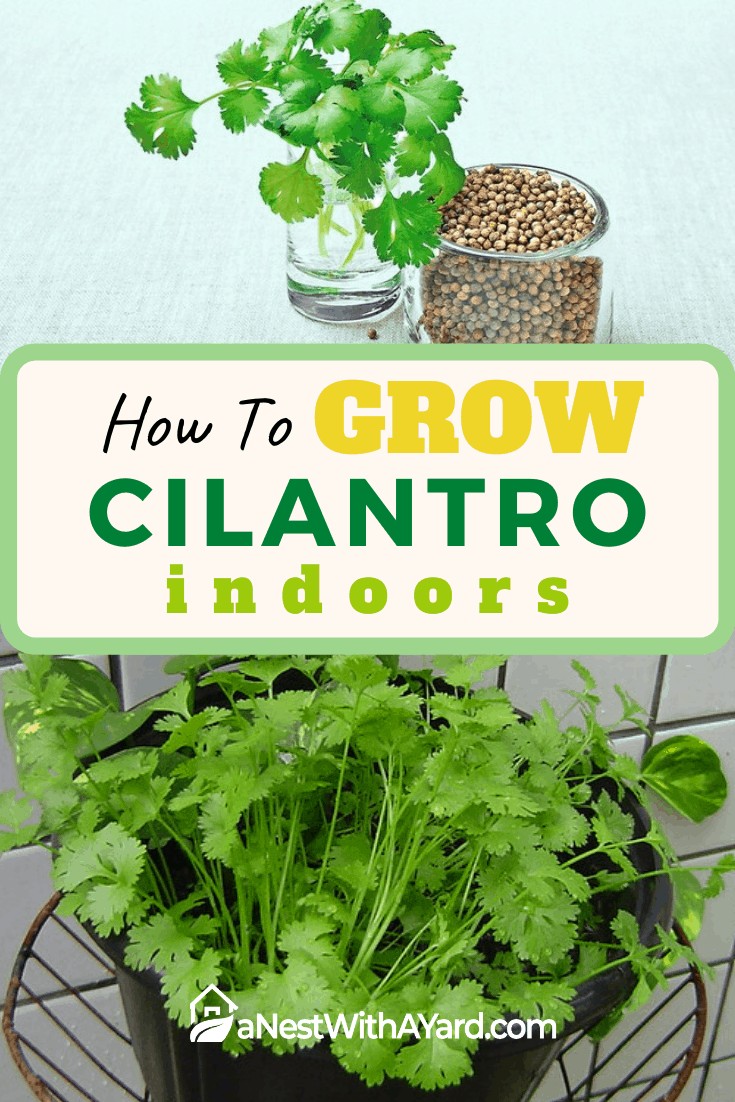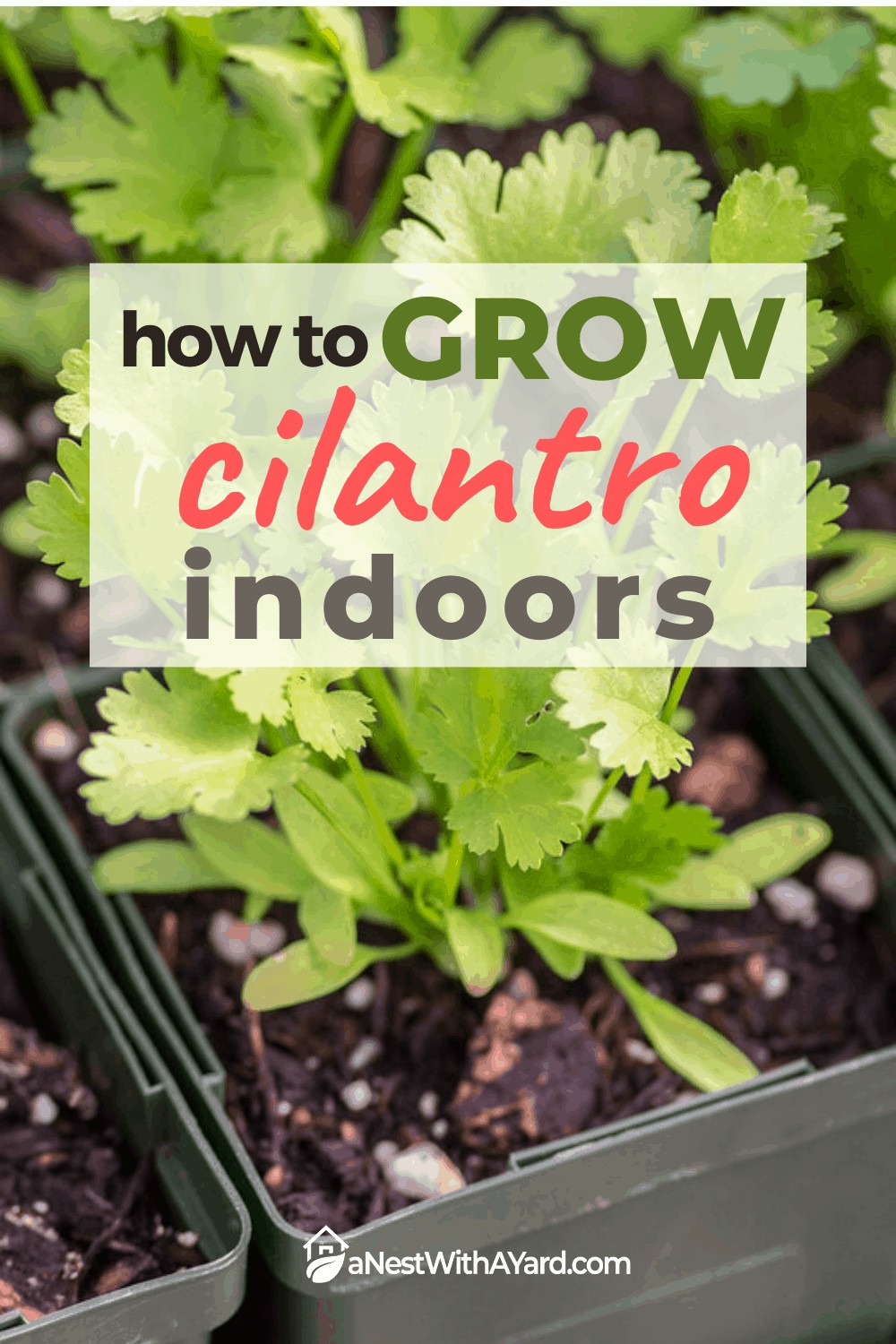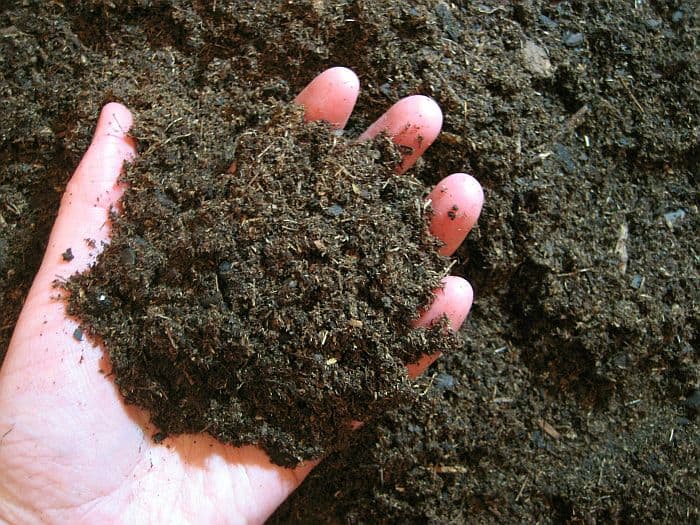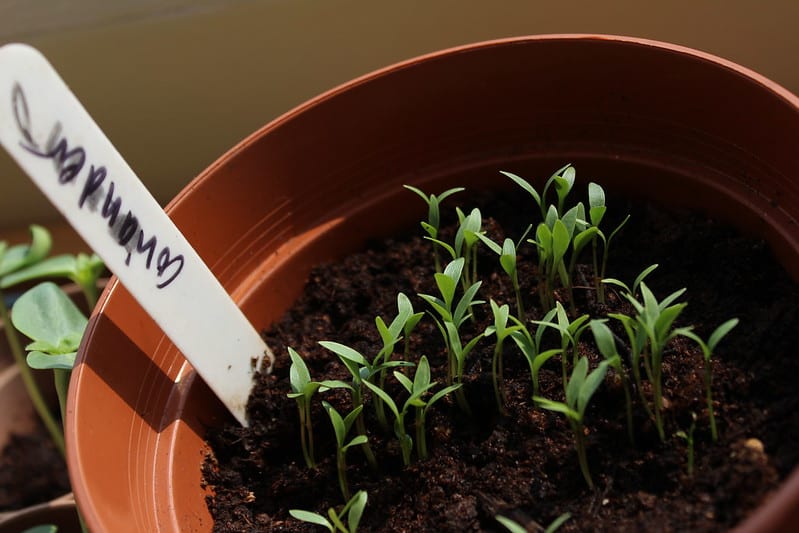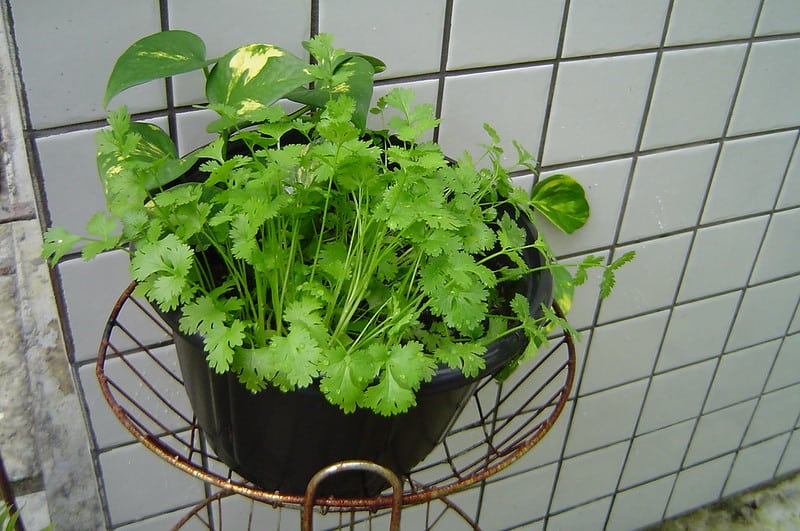When growing cilantro indoors, it’s best to plant seeds because cilantro doesn’t transplant well. Plant them 1-2 inches apart, and they’ll germinate in 7-10 days. Thin the seedlings so they’re 3-4 inches apart. Cilantro grows quickly, so harvest it frequently. Pruning will extend its harvesting stage.
Some people think cilantro tastes like soap, but I think it tastes like heaven. Its distinctive flavor is strongest in fresh-picked leaves, which is why I wrote this tutorial on how to grow cilantro indoors.
Cilantro is an ideal indoor plant. It’s easy to grow in containers, and its preferred temperature range is 50F to 85F (10C to 29.44C). To grow fresh, fragrant cilantro like this inside your house, keep reading!
Contents
Here’s What You’ll Need
List Of Supplies
If an item has an asterisk next to it, I’ll discuss it in more detail below.
- An 8-18 in (20.32 – 45.72 cm) deep container
- Potting mix *
- Cilantro seeds *
- A window with 4 – 5 hours of direct sunlight daily
- Water-soluble 10-10-10 fertilizer *
- A gentle watering method, such as a watering can
Potting Mix Vs. Potting Soil
Though “potting soil” is used interchangeably with “potting mix,” they’re not the same thing. Potting soil contains at least some soil, whereas potting mix contains none. Though each has its advantages, potting mix is always better for container gardening.
The main advantages of potting soil are its price and reusability, not its quality. Potting mix is softer, more aerated, and better at holding just enough moisture. Though potting mix eventually breaks down and loses its nutrients, you can revitalize it by adding new ingredients, such as compost and perlite.
You can also save money on potting mix by making your own. Here’s a recipe from Savvy Gardening:
- 6 gallons (22.71 liters) sphagnum peat moss
- 4.5 gallons (17.03 liters) perlite
- 6 gallons compost
- 1/4 cup (59.14 milliliters) lime
- 1 ½ cups (.24 liters) of any granular fertilizer
The lime is meant to counteract the acidity of the peat moss.
By the way, never use garden soil in containers. Because it’s high in inorganic matter, it compacts too easily and may drain too slowly. As a result, it may inhibit root growth or drown your cilantro.
It can also harbor weed seeds and diseases, as Chelsey Fields explains:
Seeds Vs. Starter Plants
Because cilantro doesn’t transplant well, it’s best to grow it from seeds. And because it has a short life cycle, slow-to-bolt varieties, like Calypso and Santo, are the most cost-effective for growing leaves.
But if your main goal is to grow cilantro seeds (AKA coriander), any variety will do.
If you hate using seeds, you can buy cilantro plants from a garden center. Just transplant them very carefully.
A Word On Fertilizer
If you’re concerned about the effects of synthetic fertilizer on the environment, you can use an organic top dressing, such as composted cow manure, in place of the 10-10-10 fertilizer.
The main advantages of synthetic fertilizer are that it works immediately and releases steady amounts of nutrients.
You also don’t need fertilizer if you’re only growing cilantro for its seeds.
Here’s How To Grow Cilantro Indoors Step By Step
To grow cilantro indoors, follow these steps:
- Find A Container
Gardening Know How recommends an unglazed terracotta container, explaining that it will allow more moisture and air to reach the cilantro’s roots. However, a container’s size and drainage ability are more important than its material.
The best container width depends on how many plants it will contain — Mature cilantro plants should be spaced 3 to 4 inches (7.62 to 10.16 centimeters) apart.
The container’s depth should be at least 8 inches (20.32 centimeters). 18 inches (45.72 centimeters) is better, however, as that’s how deep cilantro roots can grow.
For drainage, the bottom of the container should be perforated. You should also have a tray to collect drainage water. - Get Potting Mix
Cilantro needs a growing medium that’s well-draining, moist, and soft. Potting mix is the best option for this project, as it’s designed to meet these criteria in containers. As I explained before, you can make your own to save money. - Plant The Seeds
Plant your cilantro seeds 1 to 2 inches (2.54 to 5.08 centimeters) apart and about ¼ of an inch (.64 centimeters) deep.
Leave the container by a window that gets 4 to 5 hours of direct sunlight daily. Or get one of the essential indoor gardening tools, such as grow lights. - Water The Seeds/Young Seedlings Gently
To avoid washing away seeds or young seedlings, water the potting mix with something like a kitchen sprayer or watering can. CaliKim uses a water bottle with a perforated cap (see the video below).
If the potting mix stays moist, the seeds will germinate in 7-10 day - Thin The Seedlings
When you get some seedlings, thin them so that they’re 3 to 4 inches (7.62 to 10.16 centimeters) apart. Proper spacing will help your cilantro go a little longer before bolting. Additionally, it will prevent leaf spot and powdery mildew.
- Water Regularly
According to Gardening Know How, you should only water indoor cilantro when the growing medium is dry. To do a moisture touch test, stick your finger into the potting mix up to your knuckle. If the mix feels dry on your fingertip, it’s time to water it.
Each time you water your cilantro, keep going until water seeps through the pot’s drainage holes. To prevent mold, it’s a good idea to water any plant at its base to keep the leaves dry.
Each time you water your cilantro, keep going until water seeps through the pot’s drainage holes. To prevent mold, it’s a good idea to water any plant at its base to keep the leaves dry. - Fertilize Regularly
Fertilizing cilantro helps it grow more abundantly and staves off bolting. If you’re growing cilantro specifically for its seeds, however, fertilizer is unnecessary.
After your cilantro reaches 2 inches (5.08 centimeters) in height, begin applying water-soluble 10-10-10 fertilizer to the potting mix every other week. The directions on the package should tell you how.
Alternately, you can apply a top-dressing of composted cow manure as though it were mulch. Every time you water it, nutrients will wash into the soil. - Turn The Pot Sometimes
Cilantro tends to grow towards sunlight, so turning it around sometimes will help it grow evenly on all sides.
- Prune The Plants
You can make your cilantro grow bushy by pruning it. Do this when it’s small or when you won’t be using it soon.
Look for the highest leaf on each stem. Near where it connects to the stem, you’ll see a dormant leaf bud. If you pinch off the stem above that bud, it will grow one or two new leaves (cilantro tends to have dormant buds in pairs).
You can also postpone cilantro’s bolting stage by removing new flower heads. As soon as you see one, remove the upper part of the main stem. The plant will then refocus its energy on its leaves. - Harvest The Leaves As Needed
Cilantro grows very quickly, and the younger, upper leaves taste better than the lower, older ones. Harvest the younger leaves as needed.
(Image credit: flickr.com) - Replace Bolted Cilantro With New Plants (Unless You Want The Seeds)
Bolting is an inevitable part of the cilantro lifecycle. When your cilantro sends up flower stalks, its leaves will lose their distinctive flavor. At this point, you should remove the plant and replace it with a new seed.
However, if you would like to harvest cilantro seeds (coriander), give the plant time to make them. After planting, cilantro takes about 45 days to produce seeds.
To harvest cilantro seeds, wait until their pods are brown and easily crack open. Cut off the plant’s upper stems. Then, place the seed pods in a paper bag. Leave them in a cool, dark, and well-ventilated room for a few weeks to finish ripening.
After this stage, the seed pods will easily release their seeds when you shake them. You can store the seeds however you store your other dried seasonings.
If you’re a lazy gardener, you can also let cilantro replant its own seeds. Of course, you’ll still have to thin the new seedlings.
Video With Tips About Growing Cilantro
Here’s how CaliKim uses a water bottle with a perforated cap:
Store Cilantro Properly
You can’t dry cilantro leaves to use later – they’ll lose their distinctive flavor.
For the best flavor, you should only harvest them when you know you’ll use them soon. Store whole stems of fresh cilantro in your refrigerator, preferably in a glass of water and covered with a plastic bag. This method can make cilantro last two weeks or longer.
Cilantro can freeze well, although it’s likely to lose some of its flavor. The Spruce Eats outlines two ways of doing this. Whichever method you choose, you should rinse your cilantro clean and then dry it thoroughly to prevent ice damage.
Freezer Bag Method
This method preserves the flavor, but not the beauty of cilantro. Therefore, it works best if you don’t plan to use your cilantro as a garnish:
- For double insulation, place one freezer bag inside another.
- Store cilantro leaves (not stems) in the inner bag.
- Push all air out of the bags and seal each of them tightly.
- Leave them in the freezer.
- Take leaves as needed.
Note that you can also eat cilantro stems.
Ice Cube Method
Cilantro ice cubes are convenient for adding to soups and stews. This method preserves cilantro’s color better than the previous one, although the leaves will be pureed:
- In a blender, thoroughly blend your cilantro with olive oil. You can also use water, but olive oil is more flavorful and better at preserving color. Whichever liquid you choose, add a little at a time to the blender until you create a thick puree.
- Put the puree in one or more ice trays and freeze it.
- Store the frozen cubes in a plastic bag in your freezer.
- Use them at your convenience!
The Spruce Eats also recommends freezing ice cubes of cilantro pesto, which are nice to use for salads and pasta.
You Now Know How To Grow Cilantro Indoors!
I wrote this article because the best cilantro is fresh-picked, which basically means home-grown. By knowing how to grow cilantro indoors, you can now enjoy this fragrant, tasty herb at its finest, year-round!
Feeling inspired to grow more herbs inside? Check out this article for some inspiration. And if you dream of having a vegetable garden but lack space, I highly recommend the Garden Tower 2. It lets you grow 50 plants in only four square feet.
Did you enjoy my tutorial? If so, please share it with friends. If you’d like to share thoughts or concerns, please do so in the comments.
